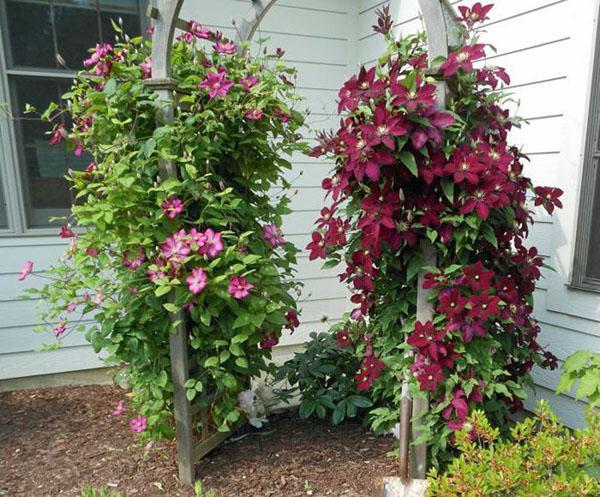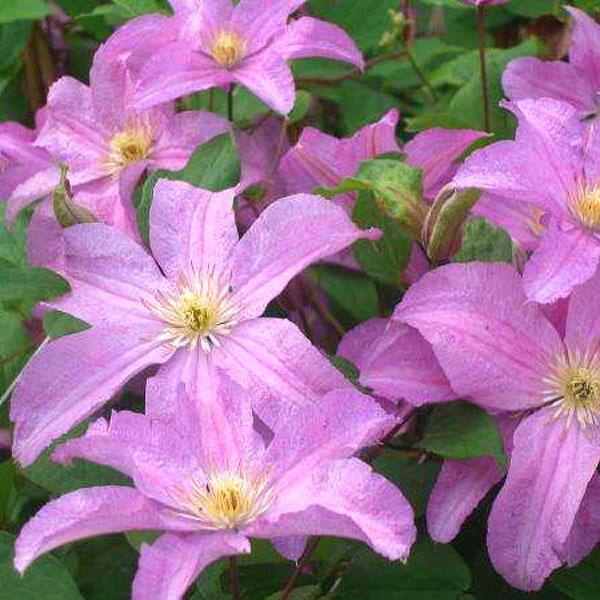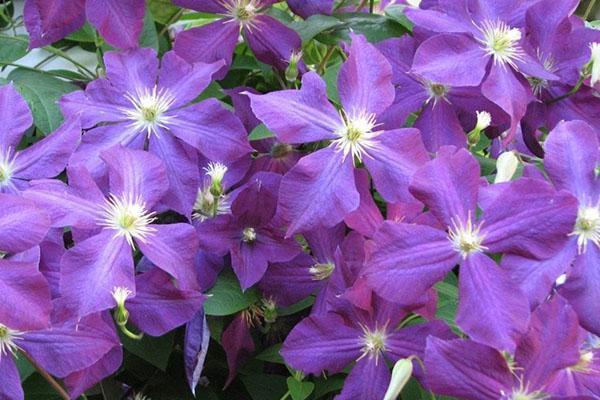We decorate our garden with clematis, having studied the rules of planting and caring for plants
 To grow beautiful clematis (as pictured), planting and care in the open field must follow certain rules. Only in this case they will delight every passer-by with a "waterfall" of colors of different shades. The plant belongs to the famous buttercup family. Due to the fact that the trunk becomes stiff after three years of its life, botanists often call clematis a wooden flower. Due to its not picky, the plant can be observed on different continents of our planet, but most often it is found in the lands of East Asia.
To grow beautiful clematis (as pictured), planting and care in the open field must follow certain rules. Only in this case they will delight every passer-by with a "waterfall" of colors of different shades. The plant belongs to the famous buttercup family. Due to the fact that the trunk becomes stiff after three years of its life, botanists often call clematis a wooden flower. Due to its not picky, the plant can be observed on different continents of our planet, but most often it is found in the lands of East Asia.
It is a unique type of flower that not only has an attractive appearance but is also very useful. It has been used in medicine for many years. Clematis able to purify the air and improve the general condition of a person.
Planting plants in the open field in the Urals

In nature, there are about 230 species of this plant, but only a few can be planted in this part of the planet.
Clematis that can easily tolerate sudden changes in temperature:
- Jacqueman. This is a vine that has rather large buds. Often in loose form, they are lilac. Shoots of this variety are capable of reaching 4 meters in length.

- Integrifolia. Shrub species, the height of which reaches 2.5 meters. The diameter of the flowers is about 12 cm. They very much resemble bells. Buds appear only on young twigs.

- Winzella. The length of the shoots of this plant can reach 3.5 meters. The leaves are complex. The flowers are large. They are often pink, purple, or red. With proper care, up to 100 buds can appear on one bush.

Clematis in the northwestern part require special planting and care. To prevent the plant from dying in winter, it should be planted in the first month of spring. Before frost, the bushes will get stronger and take root well.  Store-bought seedlings should only be placed in open areas with good sun access.
Store-bought seedlings should only be placed in open areas with good sun access.
Clematis in the Urals will thrive if planted in an area protected from the wind.
You need to plant seedlings to a depth of 20 centimeters. The groove for the flower must be prepared in advance. Its diameter should be about 0.7 centimeters. If the soil is poor, then it is better to make the dimple wider. This is necessary so that there is a place in the middle where to put the fertilizer.
 For areas where groundwater is close, use drainage. These are plants that don't like too much moisture.
For areas where groundwater is close, use drainage. These are plants that don't like too much moisture.
Clematis also react poorly to acidic and clayey soil. The best option for vines is a nutritious, loose substrate.
A lot depends on a properly prepared landing site. In order for the plant to take root quickly, a layer of sand or perlite should be laid on the bottom, which will act as a baking powder. The seedling should be wrapped with soil combined with humus.
In order to facilitate the care of the plant, young seedlings should be immediately attached to the support on which they will trail.
 Before placing the seedlings in the soil, you need to prune them. The shoots are removed enough to leave two living buds. Slices should be sprinkled with charcoal. This will keep them from rotting. After planting, the seedlings must be watered.
Before placing the seedlings in the soil, you need to prune them. The shoots are removed enough to leave two living buds. Slices should be sprinkled with charcoal. This will keep them from rotting. After planting, the seedlings must be watered.
Clematis care in the Urals
 In order for a flower to please with long, abundant flowering, one must not only know how to plant clematis, but also how to care for it. Plants that are nearby have a huge influence on its growth. Wild grapes have a beneficial effect on the development of vines, Kampsis, actinidia.
In order for a flower to please with long, abundant flowering, one must not only know how to plant clematis, but also how to care for it. Plants that are nearby have a huge influence on its growth. Wild grapes have a beneficial effect on the development of vines, Kampsis, actinidia.
Plant care rules:
- Top dressing. This is an important part of plant care. Fertilize the flower several times a year. In the spring, it is recommended to deposit funds based on nitrogen... It is best to use liquid preparations that are diluted in water before use. Nitrogen will accelerate the growth of the vine in early spring and give it lush greenery. The second procedure is carried out before budding. For this, potash compounds must be used.
 The best option is ash... You should stop feeding at the first appearance of flowers. If you continue to apply fertilizers, then the clematis stops blooming, and all its strength will go to the development of greenery. The first bloom lasts 14 days. After that, after a few days, the second phase of flowering will begin, before which a small amount of potassium fertilizer must be added again.
The best option is ash... You should stop feeding at the first appearance of flowers. If you continue to apply fertilizers, then the clematis stops blooming, and all its strength will go to the development of greenery. The first bloom lasts 14 days. After that, after a few days, the second phase of flowering will begin, before which a small amount of potassium fertilizer must be added again.
- Pruning. In order for the plant to please the eye with abundant and long flowering, this procedure is simply necessary. If mature and damaged shoots are removed, the bush quickly renews its strength, and the branches accelerate in growth. For the winter, you should cut off all the branches, leaving two, maximum three nodes above the ground.

- Preparing for the winter. Since severe cold weather is observed in the Urals for a long period of time, the bushes should be covered. For this, it is recommended to use canvases that can be bought in a specialized store.

- Pests. This type of plant has good resistance to various diseases. But, despite this, clematis still infect some diseases. One of these is Wilt's wilting. This is a disease from which, first of all, the upper leaf plates suffer. If nothing is done, then the bush may die.

The best way to get rid of diseases that affect clematis is a solution of potassium permanganate.
If you follow all the conditions for growing vines, then you can observe the exuberant flowering of this incredibly beautiful plant in a short time.
A quick way to propagate clematis by seeds
 This is one of the main methods used by gardeners. Knowing how to grow clematis from seeds, you can quickly increase the collection of this amazing flower. Liana grains can be large and small. The duration of seed germination and the ripening period of the capsules depend on them.
This is one of the main methods used by gardeners. Knowing how to grow clematis from seeds, you can quickly increase the collection of this amazing flower. Liana grains can be large and small. The duration of seed germination and the ripening period of the capsules depend on them.
The size of the bud and the bush itself does not depend on the size of the seeds.
To grow clematis from seeds at home, you must first collect the grains correctly. In plants with small seeds, harvesting of fruits can begin one month after the end of flowering, and in large ones - after 4 months. They should be stored in a room with a minimum percentage of humidity and low temperature.
Seeding stages:
- Grain preparation. Sparging is the most effective way. Thanks to him, it significantly increases the germination rate of seeds. To do this, pour a soda solution into a liter jar (2 teaspoons per 200 ml of liquid). Put the grains into the mixture and connect the aquarium compressor to them. Keep in this state for 5 hours. It is recommended to do this procedure every day for a week. At the same time, changing the water daily. Also, the grains can be placed in a growth stimulator for thirty minutes.

- Sowing.Only a wooden box should be used, the height of which is within 20 cm. It is necessary to sow the grains in a substrate consisting of peat, fez and garden soil (in equal proportions). Place drainage on the bottom of the container. For this, you can use crushed brick or expanded clay. On the soil surface, make small furrows no more than 1 cm deep. Place the grains at a distance of 5 cm from each other. Cover with soil on top and water with a spray bottle.

- Transfer. After two leaves appear on young plants, you can transplant their plastic containers.
Pinch the top. Plant in a permanent place following t after the seedlings are well grown.
t after the seedlings are well grown.
In order for the seeds to germinate quickly, it is recommended to make a mini greenhouse with polyethylene.
If everything is done correctly, then the first flowering is observed in the second or third year of their life.
 Germination can be accelerated by manually removing the protective shell. But this should be done very carefully so as not to damage the kernel.
Germination can be accelerated by manually removing the protective shell. But this should be done very carefully so as not to damage the kernel.
Planting, care and reproduction of clematis in the Urals is an opportunity to enjoy the unique flowering of the plant throughout the warm season. If you follow all the conditions, the vine will always have a beautiful appearance and will decorate any part of the site.